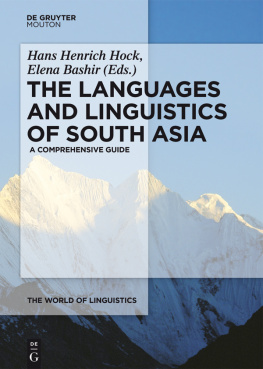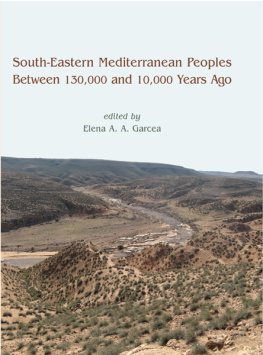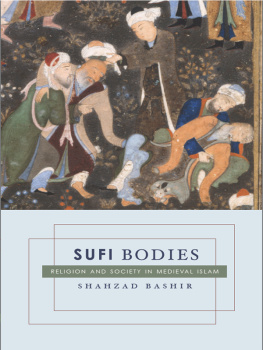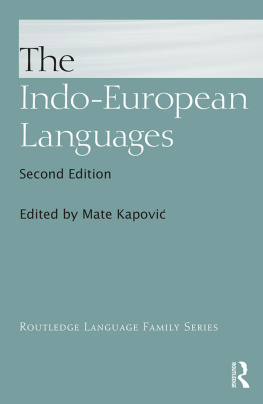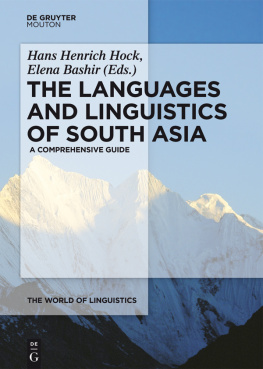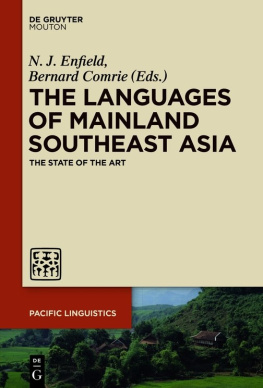Bashir Elena - The Languages and Linguistics of South Asia: A Comprehensive Guide
Here you can read online Bashir Elena - The Languages and Linguistics of South Asia: A Comprehensive Guide full text of the book (entire story) in english for free. Download pdf and epub, get meaning, cover and reviews about this ebook. City: Berlin;South Asia, year: 2016, publisher: de Gruyter Mouton, genre: Home and family. Description of the work, (preface) as well as reviews are available. Best literature library LitArk.com created for fans of good reading and offers a wide selection of genres:
Romance novel
Science fiction
Adventure
Detective
Science
History
Home and family
Prose
Art
Politics
Computer
Non-fiction
Religion
Business
Children
Humor
Choose a favorite category and find really read worthwhile books. Enjoy immersion in the world of imagination, feel the emotions of the characters or learn something new for yourself, make an fascinating discovery.
- Book:The Languages and Linguistics of South Asia: A Comprehensive Guide
- Author:
- Publisher:de Gruyter Mouton
- Genre:
- Year:2016
- City:Berlin;South Asia
- Rating:4 / 5
- Favourites:Add to favourites
- Your mark:
- 80
- 1
- 2
- 3
- 4
- 5
The Languages and Linguistics of South Asia: A Comprehensive Guide: summary, description and annotation
We offer to read an annotation, description, summary or preface (depends on what the author of the book "The Languages and Linguistics of South Asia: A Comprehensive Guide" wrote himself). If you haven't found the necessary information about the book — write in the comments, we will try to find it.
Bashir Elena: author's other books
Who wrote The Languages and Linguistics of South Asia: A Comprehensive Guide? Find out the surname, the name of the author of the book and a list of all author's works by series.
The Languages and Linguistics of South Asia: A Comprehensive Guide — read online for free the complete book (whole text) full work
Below is the text of the book, divided by pages. System saving the place of the last page read, allows you to conveniently read the book "The Languages and Linguistics of South Asia: A Comprehensive Guide" online for free, without having to search again every time where you left off. Put a bookmark, and you can go to the page where you finished reading at any time.
Font size:
Interval:
Bookmark:

The Languages and Linguistics of South Asia
WOL 7
The World of Linguistics
Editor
Hans Henrich Hock
Volume 7
De Gruyter Mouton

ISBN 978-3-11-042715-8
e-ISBN (PDF) 978-3-11-042330-3
e-ISBN (EPUB) 978-3-11-042338-9
Library of Congress Cataloging-in-Publication Data
A CIP catalog record for this book has been applied for at the Library of Congress.
Bibliographic information published by the Deutsche Nationalbibliothek
The Deutsche Nationalbibliothek lists this publication in the Deutsche Nationalbibliografie; detailed bibliographic data are available on the Internet at http://dnb.d-nb.de.
2016 Walter de Gruyter GmbH, Berlin/Boston
Cover image: Chogolisa, Karakorum/Uwe Steffens/ullstein bild
Typesetting: Drlemann Satz GmbH & Co. KG, Lemfrde
www.degruyter.com
This volume has greatly benefited from the assistance and advice of many colleagues and institutions. In the early phases of our project we were lucky to receive advice from a broad range of specialists in the field, especially Peri Bhaskararao, Agnes Korn, and K. V. Subbarao. As the project grew and we were facing problems with contributors begging off, we were lucky that E. Annamalai, Tej Bhatia, Alice Davison, Suresh Kolichala, Benjamin Slade, and Ian Smith jumped into the breaches and, often at short notice, made major contributions to the volume. They and the other contributors are the reason that this volume finally came about; we owe an immense amount of gratitude to all of them. Suresh Kolichala further contributed by creating the general map of South Asian languages and the maps of Indo-Aryan and Dravidian languages. We also express our gratitude to the staff at Mouton and de Gruyters production department who have been more than gracious, patient, and supportive, especially in the final stages of the project.
With nearly a quarter of the worlds population, members of at least five major language families plus several putative language isolates, and around 700 different languages, South Asia is a fascinating arena for linguistic investigations, whether comparative-historical linguistics, studies of language contact and multilingualism, or general linguistic theory. In addition, it offers a great variety of indigenous writing systems that pose interesting challenges to theories of writing, as well as two major indigenous traditions of phonetic and grammatical analysis, of which the Sanskrit tradition has had a tremendous influence on general phonetics and linguistic analysis.
Recent publications provide detailed information on individual language families of South Asia Steever (ed.) 1998 on Dravidian, Cardona & Jain (eds.) 2003 on Indo-Aryan, Anderson (ed.) 2008 on Munda, and relevant sections in Windfuhr (ed.) 2009 on Iranian and in Thurgood & LaPolla (eds.) 2003 on Tibeto-Burman. However, there has been no comprehensive survey of all of the South Asian languages and linguistic work on them since Current trends in linguistics 5 (Sebeok et al., eds. 1969).
The present volume is intended to provide such an updated comprehensive survey. At the same time, it differs considerably from Current trends on a number of counts, reflecting changes in research paradigms and methodologies.
Important in this regard is a much greater focus on issues of language contact and convergence, reflecting the impact of Emeneaus publications on India as a Linguistic Area (see especially Emeneau 1980) and Ramanujan & Masicas (1969) and Masicas work (1976) on the geographical distribution of South Asian convergence features.
Linguistic theory and analysis has changed dramatically from the time of Current trends . Sociolinguistic approaches, too, have developed deeper insights into such issues as code switching and code mixing, diglossia, and South Asian languages in the diaspora. Field research on minority and endangered languages has greatly expanded (although still too many languages are in danger of passing out of existence without proper documentation).
The volume is organized thematically, with contributions on different subareas by specialists in the area and in some cases by the editors themselves. Chapter 1 covers the languages, their histories, and their genetic classification. Chapter 2 deals with contact and convergence. Chapters 3, 4, and 5 focus on phonetics/ phonology, morphology, and syntax, respectively. Chapter 6 covers sociolinguistics. Chapter 7 presents an overview of indigenous South Asian grammatical traditions. Chapter 8 deals with the burgeoning field of applications of modern technology to South Asian languages. Chapter 9 covers South Asian writing systems. The volume concludes with an appendix which gives a classified listing of major sources and resources.
The Appendix is a special feature of this volume, intended to provide an even more comprehensive overview of sources and resources than what is contained in the Bibliographical references to each chapter (which also themselves include some publications not referred to in the respective chapter). While some important articles are included among the publications listed in the Appendix, the major focus is on edited volumes, monographs, and other monograph-length works. Specifically, the Appendix lists journals and periodicals; bibliographies; corpora, digital texts, and other online materials; online dictionaries; publications on language endangerment and language preservation; general linguistic surveys; and descriptions and handbooks on language families and individual languages. We hope that the information in the Appendix can be put online after publication of this volume, with provisions for subsequent online additions and updates.
Work toward this volume started in 2007. The fact that it has taken so long is partly attributable to the usual problems encountered when pursuing a project like this finding knowledgeable colleagues who are willing to contribute, making sure that they actually do contribute, and making alternative plans when things go wrong.
In part, however, the long time that it has taken toward completion is a natural consequence of the complexity of the South Asian linguistic scene. The resulting product reflects this complexity. Different languages, different geographical areas present different linguistic issues as well as different linguistic approaches. Thus, genetic subgrouping is a major issue in Modern Indo-Aryan, Iranian, and Tibeto-Burman, while even basic description and attempts at language preservation are paramount for the Andamanese languages, Kusunda, or Nihali.
There are important differences in the transcription conventions employed by our individual authors. For languages with long and rich historical documentation, an indological system developed in the late 19 th century is employed, and this system tends to be extended to many modern languages. For underdescribed and usually endangered languages, the IPA phonetic system tends to be employed, as in the examples from the Munda languages Remo and Ho (1.7.2). And many syntacticians use a system going back to early typewriter conventions, with double vowels indicating long vowels and upper-case letters indicating retroflex consonants. A guide to these different transcription systems is provided at the end of this introduction.
One regret is that we have not been able to get detailed coverage on psycholinguistic work on South Asian languages. Some discussion of psycholinguistics is found in Section 5.3 in the larger context of cognitive linguistics. Another area that, to our regret, could not be covered in detail is the newly emerging and rapidly developing work on South Asian Sign Languages. Work has progressed to the extent that there are now even publications on various dialects of Indian Sign Language, and the methods of computational linguists have also begun to be applied to sign languages. Since the medium of sign language is visual, there are a large number of resources (too numerous to list in this volume) in the form of online videos, which can be located and accessed through simple online searches. References to major published work on South Asian Sign Languages are included in the Appendix.
Font size:
Interval:
Bookmark:
Similar books «The Languages and Linguistics of South Asia: A Comprehensive Guide»
Look at similar books to The Languages and Linguistics of South Asia: A Comprehensive Guide. We have selected literature similar in name and meaning in the hope of providing readers with more options to find new, interesting, not yet read works.
Discussion, reviews of the book The Languages and Linguistics of South Asia: A Comprehensive Guide and just readers' own opinions. Leave your comments, write what you think about the work, its meaning or the main characters. Specify what exactly you liked and what you didn't like, and why you think so.

